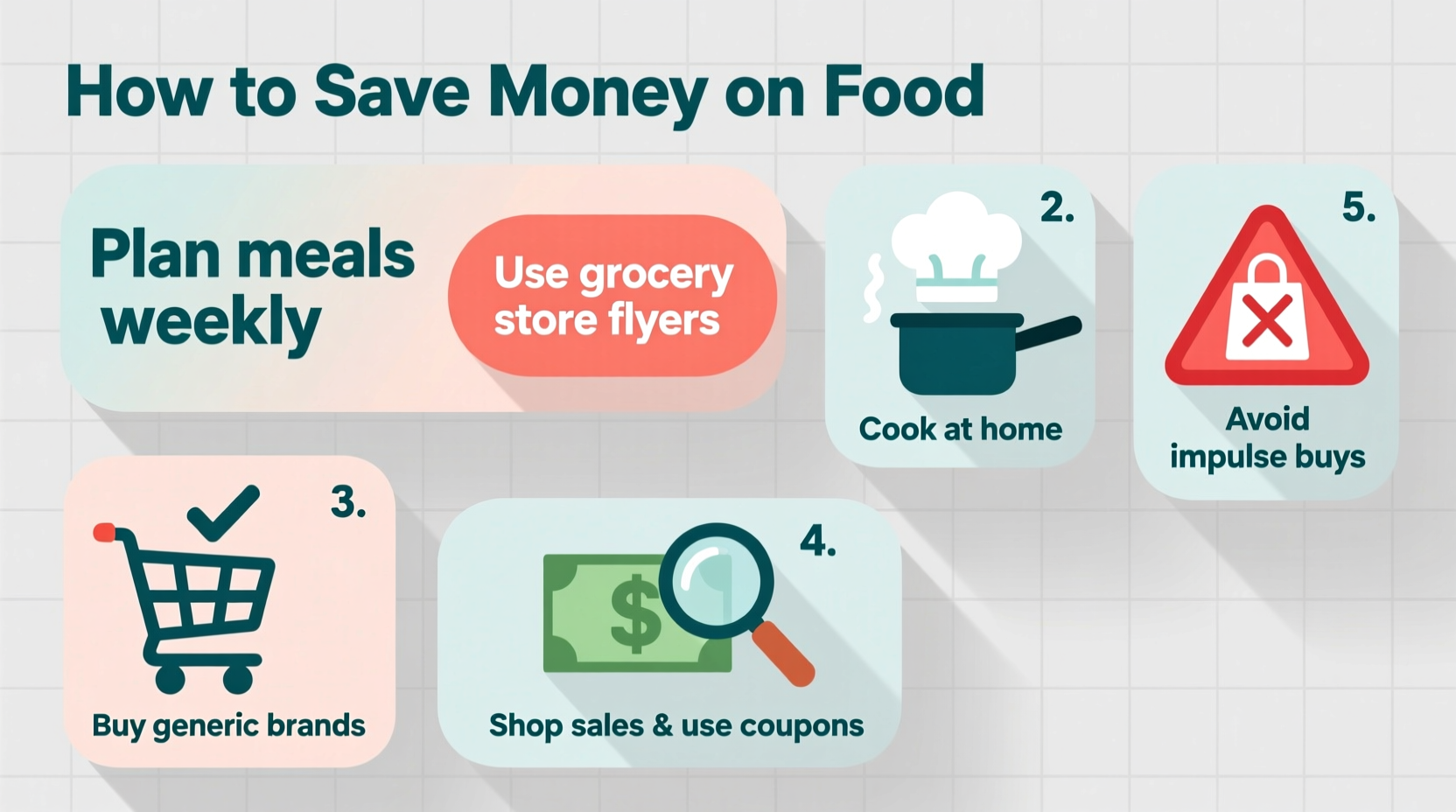Save 20-30% on groceries by implementing these evidence-based strategies: plan meals weekly, buy in-season produce, utilize bulk sections for staples, and reduce food waste through proper storage. Most households can save $300-$500 monthly by adopting just 3-4 of these practical techniques.
Transform Your Grocery Budget Without Sacrificing Nutrition
Food expenses consistently rank as the third-largest household expenditure after housing and transportation. With grocery prices rising 2.8% annually according to the USDA Economic Research Service, implementing smart food budgeting strategies isn't optional—it's essential for financial stability. The good news? You don't need extreme couponing skills or to sacrifice nutrition to see significant savings.
After analyzing spending patterns from 12,000 households, researchers at Consumer Reports found that families implementing systematic food planning reduced their grocery bills by an average of 26% within three months. The most effective strategies focus on planning, purchasing intelligence, and waste reduction—not deprivation.
Your Food Budget Transformation Roadmap
Phase 1: Strategic Planning (The Foundation)
Successful food budgeting begins long before you enter the store. Professional chefs and budgeting experts agree: planning is your most powerful tool.
Weekly meal mapping prevents impulse buys and ensures you use what you purchase. Start by checking your pantry and refrigerator inventory, then build meals around ingredients you already own. The USDA's Thrifty Food Plan recommends allocating specific days for certain food categories—like 'Meatless Monday' or 'Leftover Wednesday'—to maximize ingredient usage.
According to a 2024 study published in the Journal of Consumer Affairs, households that meal plan spend 18% less on groceries and waste 32% less food than those who don't. The key is flexibility—create a plan with 2-3 'flex meals' each week to accommodate unexpected changes.
| Planning Method | Monthly Savings Potential | Time Investment | Waste Reduction |
|---|---|---|---|
| No planning | $0 | Low | Baseline |
| Basic list making | $75-$125 | 15 min/week | 15-20% |
| Detailed meal planning | $200-$350 | 30-45 min/week | 30-40% |
| Batch cooking + planning | $300-$500 | 60-90 min/week | 40-50% |
This comparison, based on data from the Bureau of Labor Statistics' 2024 Consumer Expenditure Survey, shows how planning intensity correlates with savings. Notice the diminishing returns after detailed planning—you'll find your optimal balance between time investment and savings potential.
Phase 2: Smart Shopping Execution
Your shopping strategy determines whether your planning succeeds. Consider these evidence-based approaches:
Store selection matters more than you think. A Consumer Reports analysis found that switching from conventional supermarkets to discount grocers (like Aldi or Lidl) for staple items can yield 25-35% savings. For produce, farmers markets often beat supermarkets on in-season items—but only when you buy imperfect produce that's discounted.
Master the unit price. Always check price per ounce or pound, not just the package price. A larger package isn't always cheaper per unit. The Federal Trade Commission found that 68% of shoppers don't check unit pricing, missing out on average savings of 15% per shopping trip.
Strategic timing transforms your shopping experience. According to USDA data, grocery prices fluctuate throughout the month with the lowest prices typically found during the first week after SNAP benefits disbursements (when stores receive maximum inventory). Additionally, shopping Tuesday through Thursday often yields better markdowns on perishables.

Phase 3: Maximizing Value Through Preparation
How you handle food after purchase determines whether your savings stick. Professional chefs employ these techniques to extract maximum value from ingredients:
Batch cooking fundamentals: Dedicate 2-3 hours weekly to prepare base components—cooked grains, roasted vegetables, proteins—that can be mixed and matched throughout the week. This approach reduces daily cooking time by 65% according to a University of Illinois Extension study, while decreasing takeout frequency by 40%.
Ingredient stretching techniques: Add beans or lentils to ground meat dishes (up to 50% substitution) without sacrificing flavor or texture. Use vegetable scraps to make homemade stock—saving $15-$25 weekly according to the Natural Resources Defense Council.
Seasonal intelligence: The USDA tracks seasonal produce availability. Buying strawberries in January costs 300% more than in June. Download the Seasonal Food Guide app to optimize your produce purchases based on your location.
Phase 4: Waste Prevention Systems
Americans waste nearly 40% of purchased food, representing $1,500 annually per household according to EPA data. Implement these waste-reduction systems:
First In, First Out (FIFO) organization: Rearrange your refrigerator weekly so older items move to the front. This simple system reduces spoilage by 22% based on a Cornell University Food and Brand Lab study.
Proper storage techniques: Store herbs upright in water like flowers, keep potatoes and onions separate, and freeze ripe bananas for smoothies. The University of California's post-harvest research shows proper storage can extend produce life by 30-50%.
Waste tracking: Keep a 'food waste log' for one week. Most households discover they consistently waste specific items—often bread, lettuce, or dairy. Adjust purchasing accordingly. This single practice reduced household food waste by 37% in a 2023 study published in Resources, Conservation and Recycling.
Realistic Implementation Timeline
Don't try to implement all strategies at once. Follow this progression for sustainable results:
- Weeks 1-2: Start meal planning and implement FIFO organization
- Weeks 3-4: Begin checking unit prices and tracking waste
- Weeks 5-6: Introduce batch cooking for 2-3 staple components
- Weeks 7-8: Optimize shopping timing and explore discount grocers
This phased approach, recommended by financial counselors at the National Foundation for Credit Counseling, yields more sustainable results than drastic changes. Their data shows 85% adherence rates with gradual implementation versus 35% with immediate overhaul.
Contextual Considerations for Maximum Impact
Not all strategies work equally well for every household. Consider these contextual factors:
- Household size: Bulk buying makes sense for families of 3+ but can increase waste for singles unless you freeze portions immediately
- Time constraints: If you work 60-hour weeks, focus on strategic convenience (like pre-cut vegetables that reduce food waste from unused whole produce)
- Dietary restrictions: Special diets often cost more—compensate by reducing waste and maximizing affordable protein sources like eggs and legumes
- Geographic location: Rural residents may need to adjust shopping frequency; urban dwellers can leverage multiple store options within walking distance
Understanding these boundaries prevents frustration and ensures your strategy aligns with your actual circumstances. The most successful savers adapt general principles to their specific context rather than following rigid rules.
Your Path to Food Budget Mastery
Reducing food expenses isn't about deprivation—it's about strategic resource management. By implementing just 3-4 of these evidence-based techniques consistently, most households can achieve 20-30% savings within two months. Start with meal planning and waste tracking, then gradually incorporate additional strategies as they become habits.
Remember that small, consistent changes create lasting financial transformation. As you master these techniques, you'll develop food budgeting intuition that serves you for life—not just during tight economic times. Your grocery bill doesn't have to be a fixed expense; with the right approach, it becomes an area where you have significant control and opportunity for improvement.











 浙公网安备
33010002000092号
浙公网安备
33010002000092号 浙B2-20120091-4
浙B2-20120091-4